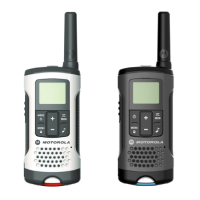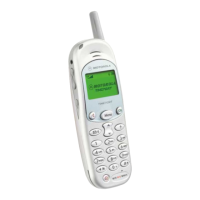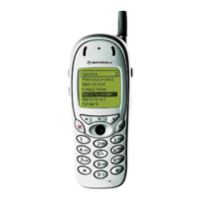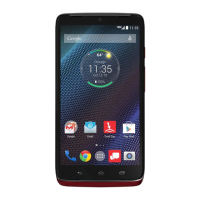Topaz T2688/T200, T2988/T205 L3 Circuit Description
15
Motorola Proprietary Information
Display
95. The LCD module is a 98 X 64, Chip on Glass device and measures 37 x 33mm with a
polyamide foil connection to the PCB through U24. Support for the LCD is through
DVCC.
96. Contrast control is achieved by the variation in voltages, which are stored in C40
through C44 and DC / DC LCD driving voltages provided by C45 through C48.
97. Data to and from the LCD is though the data bus D0 – D7, U24 Pins 16 – 24
98. Chip select is sent from Gemini Pin 48 to LCD Connector Pin 28, with the Reset on
connector on Pin 27.
Vibrator and Alert
99. The vibrator is driven by the signal AAGC which originates from VEGA Pin 45, this
signal is applied to the base of Dual NPN / PnP transistor U44, this then causes the
second transistor to conduct forcing the collector high. This then effectively give s the
vibrator support voltage VBAT a path to earth through BQ1
100. U6 provide EMF protection.
101. The buzzer / alert is operated, using the signal BUZZER from Gemini Pin 20,
this signal forces BQ4 to conduct creating the current path for the buzzer U8 support
voltage VBAT to earth.
102. U7 Provides EMF protection for the buzzer.
Keypad and Back lights
103. The backlights are split into 3 for the LCD (D1 – D3) and the keypad backlights
of which there are 8 (D4 – D11). The backlights are switched on using the signal
LEDON (This is generated from Keypad detect switch U34 and is switched by the
signal BL from Gemini Pin 134. LEDON then forces BQ2 to conduct allowing the
support voltage VBAT to illuminate the backlights.
104. The keypad is made up of a 4 column x 5 Row matrix, with the signals ROW4 –
ROW 0 being generated from Gemini Pins 126 to Pins 122 respectively. The column
signals, COL3 Gemini Pin 129, COL2 Pin 128, COL1 Pin 133 & COL0 Pin 132.
105. The 2 signals ROW4 and COL4 are used as outputs from the Gemini to Keypad
detect switch U34 to inform the unit to switch on during sleep mode.

